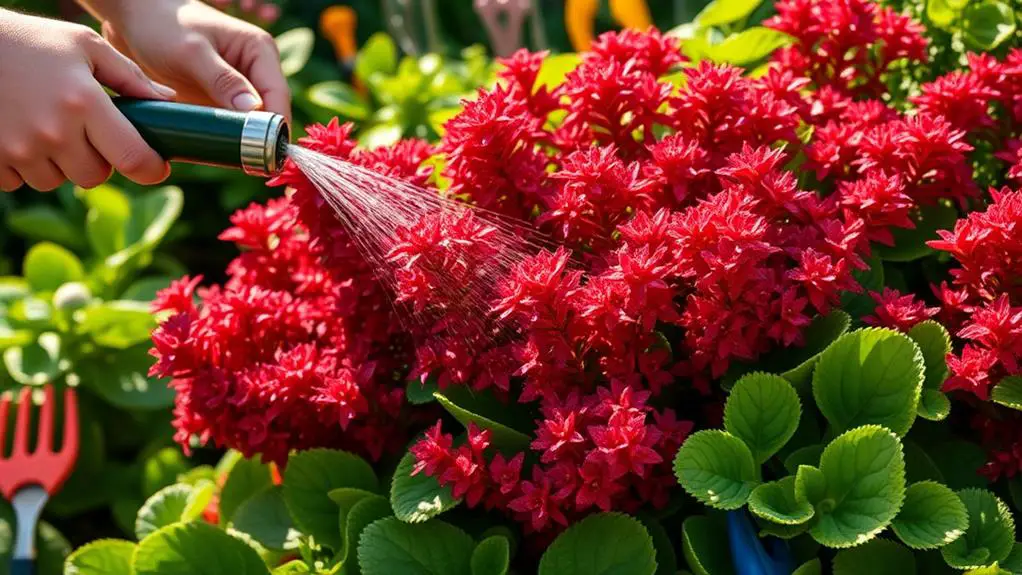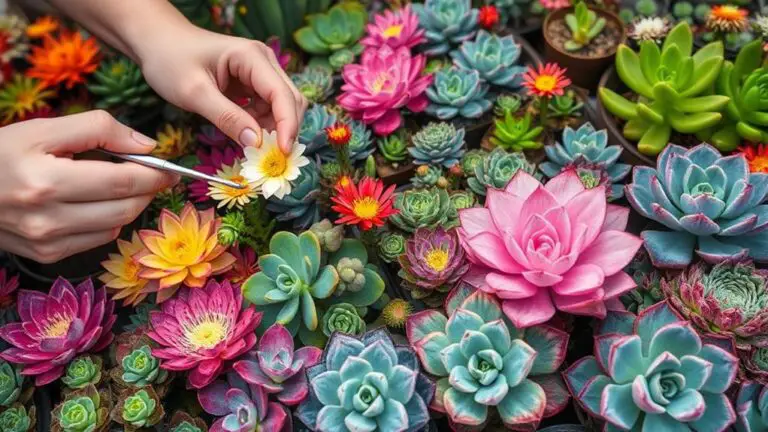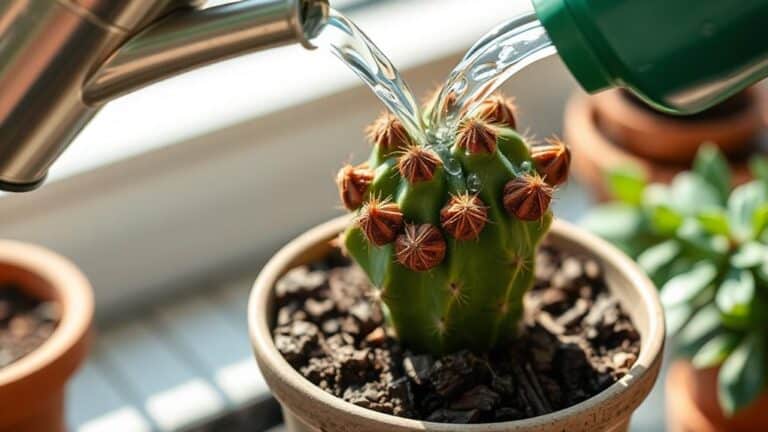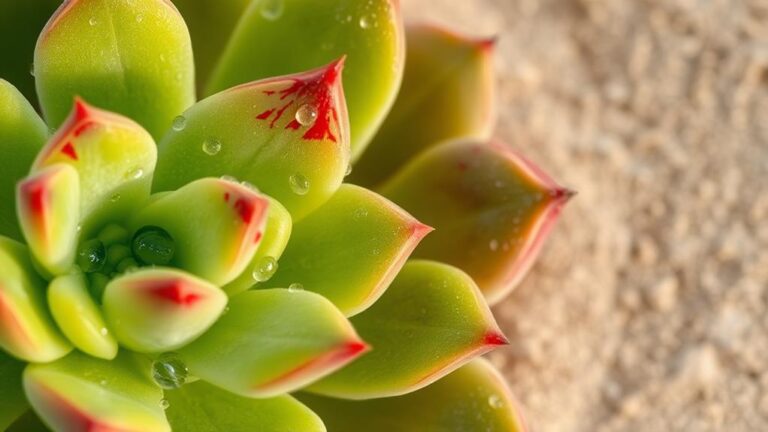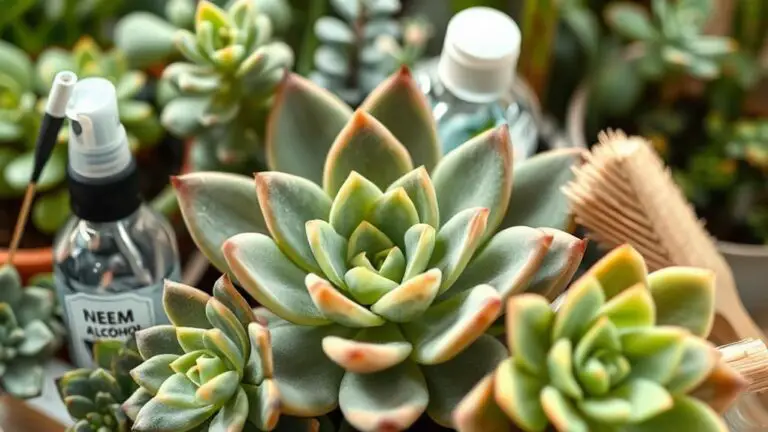10 Steps to Make Your Dragon’s Blood Sedum Bloom
To make your Dragon's Blood Sedum bloom vibrantly, you'll need to follow a strategic approach. Start by ensuring it gets at least six hours of sunlight each day. Next, focus on the soil; a mix of loam and sand works wonders for drainage. Don't forget the soak and dry watering method to prevent root rot. You should also fertilize bi-weekly with a balanced blend. Now, imagine what happens when you prune dead stalks in early spring and inspect for pests regularly. But wait, there are a few more critical steps that will take your Sedum's blooming to the next level.
Ensure Proper Sunlight
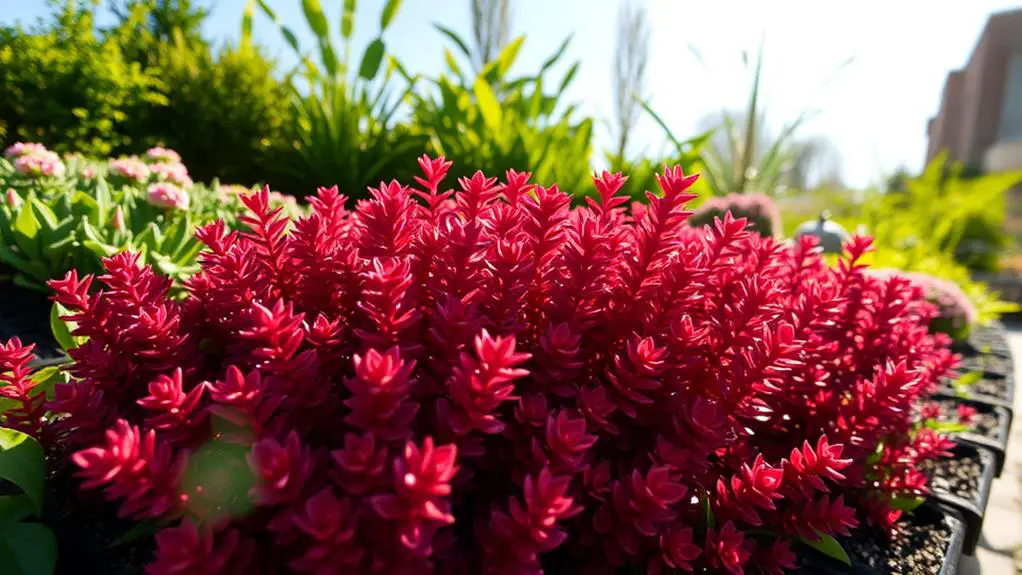
How can you make certain your Dragon's Blood Sedum blooms beautifully? It all starts with giving your plant the right amount of sunlight. To achieve vibrant blooms, guarantee your sedum gets at least 6 hours of full sun daily. This amount of exposure is essential because the plant relies on sunlight for energy and growth. Without enough sunlight, you might see fewer flowers or none at all.
Placing your Dragon's Blood Sedum in a south or east-facing location indoors maximizes its exposure to natural light. These orientations typically provide the necessary sunlight for your plant to thrive. During the hottest parts of the day, offering some afternoon shade can protect your sedum from extreme heat, while still providing adequate light for blooming.
If you're growing your sedum indoors and natural light isn't sufficient, don't worry. You can use grow lights to supplement. Choose lights with a color temperature around 3000K to mimic the sun's natural rays, which will help enhance blooming potential.
With the right light conditions, your Dragon's Blood Sedum will reward you with a stunning display of vibrant flowers.
Use Well-Draining Soil
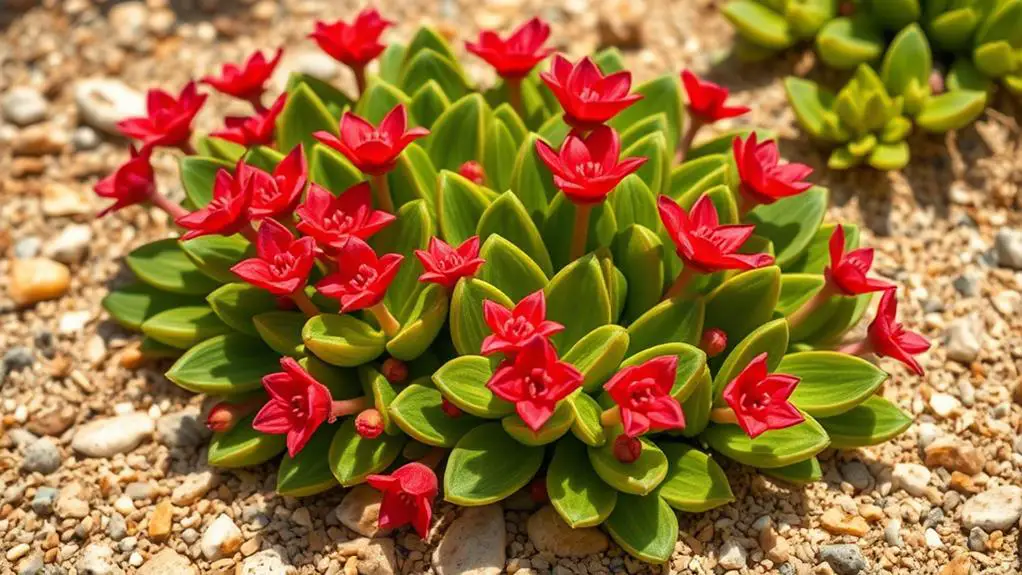
Using well-draining soil is vital for the health and blooming potential of your Dragon's Blood Sedum. You want to start by creating a good soil mix that includes loam and sand. This combination helps with proper drainage and keeps the roots from sitting in water, which can cause root rot.
Verify that your container has drainage holes or plant your sedum in a well-draining garden bed. This prevents water from accumulating around the roots. You can also enhance your soil by adding compost. The compost will provide necessary nutrients while keeping the soil loose for peak drainage.
Monitoring the soil moisture levels is essential. Allow the top half-inch of soil to dry out completely before you water again. This helps maintain healthy root conditions. Remember to repot your sedum every couple of years to refresh the soil. Repotting guarantees better drainage and sustained plant health, which promotes blooming.
Here's a quick guide to help you remember:
| Tips for Well-Draining Soil | Benefits |
|---|---|
| Use loam and sand in soil mix | Prevents root rot |
| Verify containers have drainage holes | Avoids water accumulation |
| Add compost to soil | Enhances nutrients and texture |
| Monitor soil moisture | Maintains healthy roots |
| Repot every few years | Sustains plant health |
Adopt Appropriate Watering Techniques
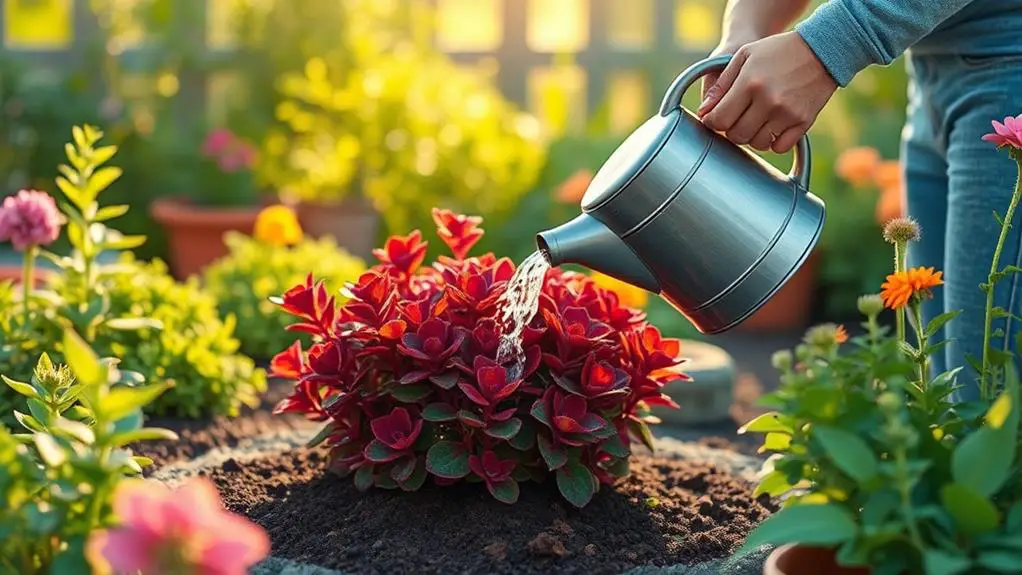
Proper soil setup is just one part of ensuring your Dragon's Blood Sedum thrives. To make your plant bloom beautifully, you'll need to adopt appropriate watering techniques.
Start with the soak and dry method. Water your plant thoroughly, then let the soil dry out at least half an inch before you water again. This prevents overwatering, which can hinder blooming.
Only water your Dragon's Blood Sedum during the growing season. In winter, reduce the watering frequency to keep the roots from rotting and to avoid stressing the plant.
Make sure your soil is well-draining—a mix of loam and sand works best. Good drainage supports healthy root growth and blooming conditions.
Check soil moisture regularly. Signs of distress from over or under-watering, like yellowing leaves or stunted growth, can affect your plant's ability to bloom.
Using containers with drainage holes can enhance soil drainage, preventing water from accumulating and promoting ideal blooming conditions.
Apply Balanced Fertilizer
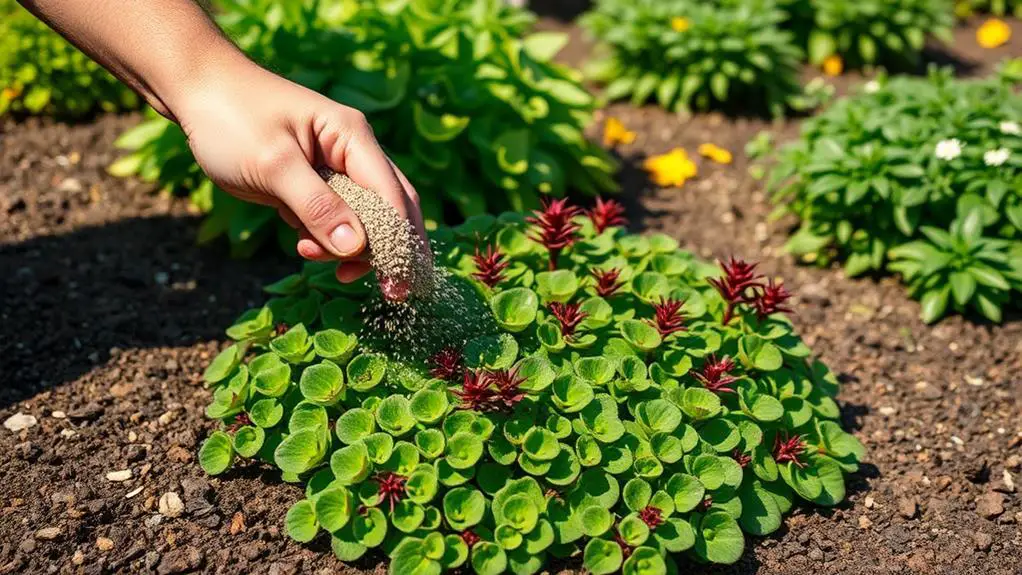
To guarantee your Dragon's Blood Sedum blooms to its full potential, apply a balanced fertilizer with equal parts Nitrogen (N), Phosphorus (P), and Potassium (K). This balanced fertilizer supports healthy growth and blooming by providing your plant with the essential nutrients it needs.
During the growing season, which runs from spring through early fall, you should fertilize your sedum every two weeks. This guarantees the plant has adequate nutrient availability to thrive and produce vibrant flowers.
Phosphorus is especially important for your sedum. It stimulates root development and promotes flower formation, both vital for blooming success. When you apply the fertilizer, use it at quarter or half strength to avoid over-fertilization, which can stress the plant.
It's also important to monitor your plant's response to the fertilizer. If you notice any signs of stress or poor growth, adjust the frequency or concentration accordingly.
Prune Dead Stalks
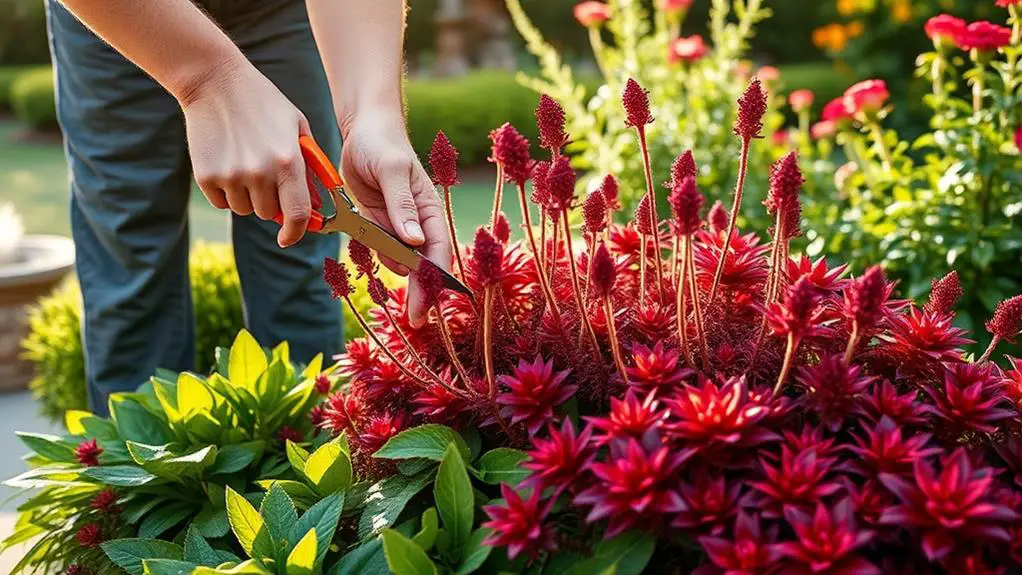
To make sure your Dragon's Blood Sedum blooms beautifully, start by pruning dead stalks in early spring.
Use sharp pruning shears for clean cuts, which helps prevent damage and disease.
Removing dead stems encourages new growth and allows more light and air to reach the plant, setting the stage for vibrant flowers.
Timing for Effective Pruning
Pruning dead stalks of Dragon's Blood Sedum in early spring is essential for encouraging new growth and boosting overall plant health. As the winter ends, your Dragon's Blood Sedum may look a bit scraggly with some dead stalks. Don't worry; this is the perfect time to give it a little TLC with some strategic pruning.
Here's why early spring is the best time for this task:
- Encourages New Growth: Pruning in spring stimulates the growth of new stems.
- Boosts Plant Health: Removing dead stalks improves air circulation.
- Enhances Appearance: It promotes a bushier, more attractive plant.
- Prepares for Blooming: Pruning sets the stage for a spectacular bloom.
Aim to prune before the growing season kicks into high gear, usually around late March to early April. By doing so, you're giving your plant the best chance to thrive.
Look for any dead or damaged stalks that didn't survive the winter. Use sharp pruning shears to make clean cuts close to the base of the plant. This helps prevent any damage and reduces the risk of disease.
With a little effort, your Dragon's Blood Sedum will be ready to spring into action, offering lush growth and vibrant blooms.
Tools for Clean Cuts
Wondering how to make clean cuts when pruning your Dragon's Blood Sedum? Using the right tools for clean cuts is essential for promoting healthy growth. Sharp pruning shears are your best friend for this task. They guarantee you make clean, precise cuts on dead stalks, which helps avoid damaging the plant and encourages new growth. It's best to prune in early spring when the plant starts to show signs of life, as this allows the Dragon's Blood Sedum to focus its energy on fresh foliage and blooms.
Make certain your pruning tools are sanitized before use to reduce the risk of disease transmission between plants. When cutting, aim to trim dead stalks back to the base or just above healthy growth. This not only maintains an aesthetically pleasing appearance but also promotes bushier growth. Regularly inspect the plant throughout the growing season for any dead or damaged leaves and remove them promptly to enhance overall health and blooming potential.
| Task | Tools Needed |
|---|---|
| Pruning Dead Stalks | Sharp Pruning Shears |
| Sanitizing Pruning Tools | Disinfectant Solution |
| Inspecting Plant Health | Gloves, Pruning Shears |
Monitor Soil Moisture
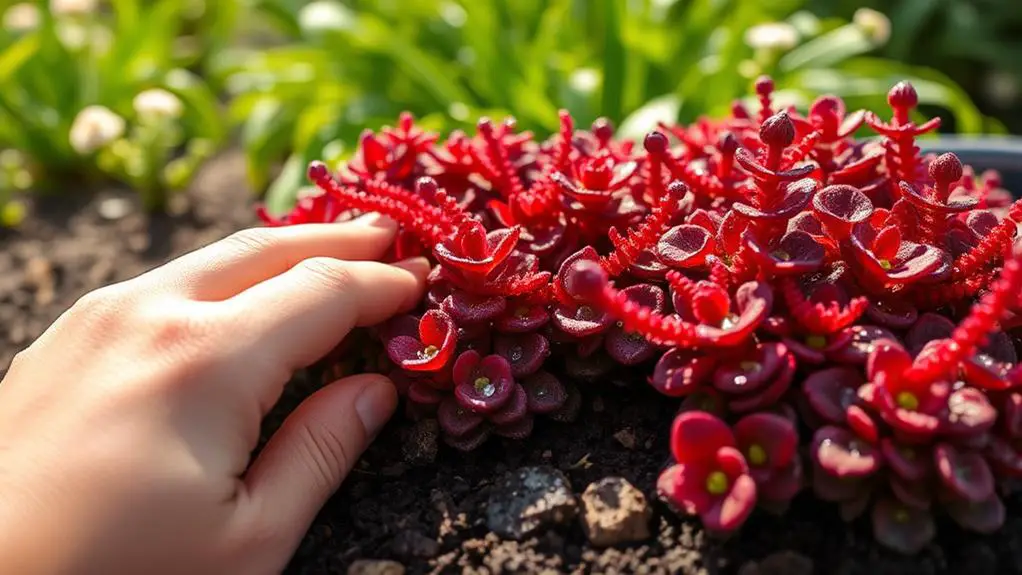
Consistently monitoring soil moisture is vital for encouraging your Dragon's Blood Sedum to bloom.
To keep your plant healthy and blooming, ascertain the top half-inch of soil is completely dry before you water it again. This prevents overwatering, which can hinder blooming and harm your plant.
Use the soak and dry method for watering. Thoroughly soak the soil and then let it dry out completely before the next watering session. This helps maintain well-drained soil, essential for your sedum's health.
Here are some practical tips:
- Check soil dryness: Use your finger to feel the top half-inch of the soil. If it's dry, it's time to water.
- Observe plant health: Look for signs like leaf drop or discoloration, which might indicate moisture issues.
- Adjust watering routine: Water infrequently during the growing season, and reduce the frequency in winter months.
- Improve drainage: If the soil retains too much moisture, repot your sedum with a mix of loam and sand.
Choose Suitable Containers
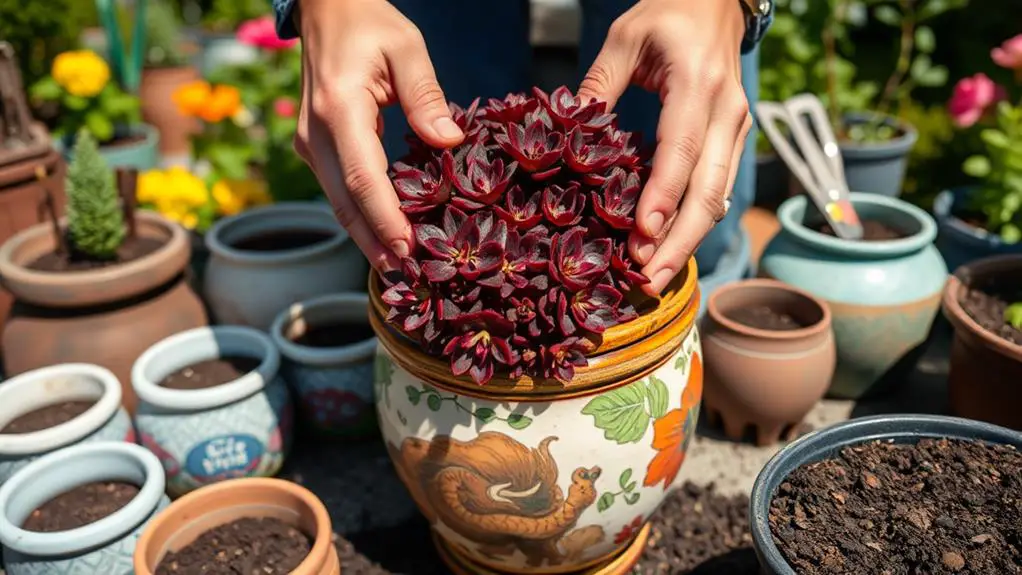
Choosing suitable containers for your Dragon's Blood Sedum is vital for its growth and blooming. Start by selecting containers that are at least 4 inches in diameter. This size will give your plant enough root space, promoting healthy development.
Confirm the containers you choose have drainage holes. Proper drainage is important because it prevents water from accumulating at the bottom, which can cause root rot.
Opt for well-draining materials like terra cotta. Terra cotta absorbs excess moisture, helping maintain well-drained soil and improving airflow to the roots.
Because Dragon's Blood Sedum has a mat-forming growth habit, it doesn't need deep soil. Shallow containers are perfect for this type of plant, as they provide the right environment without wasting space.
If you prefer decorative pots, make certain to include a layer of gravel or rocks at the bottom. This layer will enhance drainage and prevent the soil from becoming compacted, guaranteeing your plant's roots stay healthy.
Check for Pests

To keep your Dragon's Blood Sedum healthy and blooming, regularly check for pests like aphids and mealybugs.
Use a magnifying glass to spot any tiny invaders hiding on the undersides of leaves or in leaf axils.
If you find pests, treat the plant with insecticidal soap or neem oil right away.
Identify Common Pests
When you want your Dragon's Blood Sedum to thrive and bloom, it's crucial to keep an eye out for common pests that can hinder its growth. Regularly inspect the undersides of leaves and stems for pests like aphids, mealybugs, and spider mites. These tiny invaders can stunt your plant's development and prevent it from flowering.
Look for sticky residue or webbing on your Dragon's Blood Sedum. These are telltale signs of pest infestations. A magnifying glass can be very helpful to spot the tiny pests that are difficult to see with the naked eye.
Here are some steps you can take to guarantee your sedum stays pest-free:
- Inspect regularly: Check leaves and stems for any signs of pests.
- Detect residue: Look for sticky residue or webbing, which indicates pest problems.
- Use insecticidal soap: This can help control pest populations without harming your plant.
- Maintain a healthy environment: Confirm your plant has well-drained soil and adequate sunlight to promote strong growth.
Natural Pest Control
Keeping pests at bay is essential for the health and blooming of your Dragon's Blood Sedum. Regularly inspecting your plant for common pests like aphids and mealybugs is the first step. These pests can hinder blooming and overall plant health if not addressed promptly. A strong spray of water can be an effective initial step to dislodge these pests without using chemicals.
Introducing beneficial insects such as ladybugs and lacewings to your garden can also help. These insects prey on aphids and help maintain a balanced ecosystem, keeping your sedum healthy. If you notice a more significant infestation, apply neem oil or insecticidal soap. These natural treatments are less harmful to beneficial insects compared to synthetic pesticides.
Ensuring good air circulation around your Dragon's Blood Sedum is another vital step. Avoid overcrowding your plants, as this can deter pests and reduce the likelihood of disease.
Proper spacing allows air to flow freely, making it harder for pests to thrive.
Regular Health Monitoring**
Regular health monitoring is essential for ensuring your Dragon's Blood Sedum thrives and blooms. To keep your plant in top shape, you need to check for pests regularly. Common pests like aphids and mealybugs can cause serious issues, including discoloration and wilting leaves. These signs indicate your plant is under stress, either from pests or environmental factors.
Start by inspecting your plant closely. Use a magnifying glass to check the undersides of leaves, where pests often hide. This thorough inspection helps you catch problems early.
Here are some key tips for regular health monitoring:
- Inspect for pests: Look for tiny insects like aphids and mealybugs.
- Check for discoloration: Yellowing or wilting leaves can signal trouble.
- Maintain cleanliness: Remove dead leaves and debris to prevent pest habitats.
- Use treatments: If you find pests, apply insecticidal soap or neem oil promptly.
Maintain Ideal Temperature
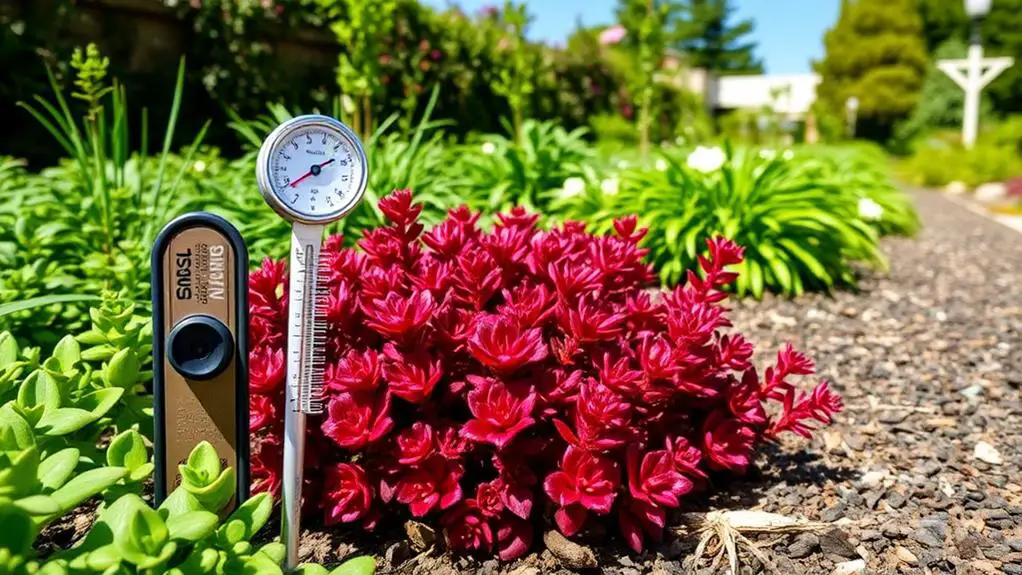
Maintaining the ideal temperature is vital for getting your Dragon's Blood Sedum to bloom. To guarantee your plant thrives, monitor temperature fluctuations closely.
Dragon's Blood Sedum is hardy, with a range from -30 to 30°F, making it suitable for USDA zones 3-9. However, keeping the temperature within this hardiness range, especially during the growing season, is critical for maximizing blooming potential.
During the winter months, avoid exposing your sedum to temperatures below its hardiness range. This plant can tolerate cold weather, even frost, but consistent warmth during the growing season is vital for encouraging those beautiful blooms.
If temperatures rise above 90°F, provide some afternoon shade to prevent stress on the plant, which can hinder blooming.
Pay special attention to container plants, as they're more susceptible to temperature fluctuations. Keeping the roots from getting too stressed will promote healthier and more vibrant blooms.
By maintaining a stable temperature and providing the right conditions, you'll help your Dragon's Blood Sedum reach its full blooming potential.
Use Organic Nutrients
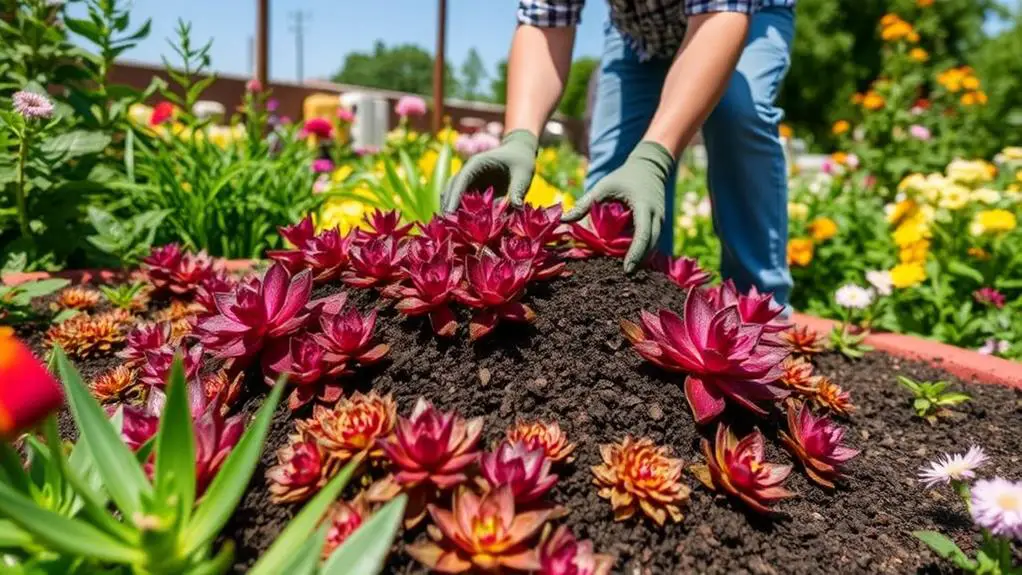
To boost your Dragon's Blood Sedum's blooming potential, turn to organic nutrients for a natural and effective solution. Organic fertilizers like coffee grounds or banana peel water are fantastic choices. They provide essential nutrients, promoting healthy growth and vibrant blooms.
You should apply these organic fertilizers at quarter or half strength every two weeks during the growing season. This approach enhances flowering without overloading the plant.
Incorporating compost into the soil mix is another great step. Compost improves nutrient content and drainage, creating an ideal environment for your sedum to thrive.
Plus, regularly checking the nutrient levels in the soil is vital. While Dragon's Blood Sedum does well in nutrient-poor conditions, it benefits from occasional organic amendments.
Using organic nutrients not only supports healthy growth but also helps your plant resist pests and diseases. This resilience guarantees a more productive blooming cycle.
Here are some practical tips:
- Use coffee grounds or banana peel water as organic fertilizers.
- Apply fertilizers every two weeks at quarter or half strength.
- Mix compost into the soil to enhance nutrient content.
- Check soil nutrient levels regularly for peak growth.
Frequently Asked Questions
How Do I Get My Sedum to Bloom?
To get your Sedum to bloom, guarantee it gets at least 6 hours of full sun daily. Use a balanced fertilizer biweekly, water using the soak and dry method, prune dead stalks, and monitor for pests.
How to Care for Dragon Blood Sedum?
Make certain your Dragon's Blood Sedum thrives by planting it in well-draining soil, placing it in full sun, watering infrequently, fertilizing during the growing season, and pruning dead stalks in early spring for ideal care and blooming.
How Long Does It Take Sedum to Flower?
It takes Dragon's Blood Sedum several weeks to flower, usually starting in late summer to early fall. Make certain your plant gets at least 6 hours of sunlight and well-draining soil for the best blooming results.
Does Dragon's Blood Sedum Come Back Every Year?
Yes, your Dragon's Blood Sedum comes back every year. This hardy perennial dies back in winter and regrows in spring. With proper care, it reliably returns, adding vibrant color to your garden annually.
Conclusion
By following these ten steps, you'll give your Dragon's Blood Sedum the best chance to thrive and bloom beautifully. Remember to provide enough sunlight, use well-draining soil, and water correctly. Don't forget to fertilize, prune, and check for pests regularly. Maintain the right temperature, choose the right containers, and add organic nutrients. With a bit of care and attention, your Sedum will reward you with vibrant, stunning blooms. You've got this—happy gardening!

